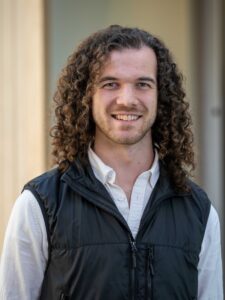
CUOS Seminar | Optics Seminar
CUOS Noon Seminar: Colliding Plasma Plumes, MeV proton beams, Positron Beams, and Pizza!
This event is free and open to the publicAdd to Google Calendar
Joshua Latham: Magnetic field generation mechanisms of a relativistic laser between colliding magnetized plasma plumes
 Experiments which measure the magnetic fields of laser-driven plasmas give insight into the basic processes of plasmas such as magnetic reconnection. These processes become more difficult to describe when there is a mixture between regimes, such as between relativistic kinetic plasma and MHD-describable plasma, as in this case. In this experiment, a 10-ps, 10^19 W/cm^2 infrared (IR) laser impinged on the interface between two plasma plumes driven by 2.5 ns, 10^14 W/cm^2 ultraviolet (UV) lasers at the OMEGA-EP laser facility. The magnetic fields were measured with proton radiography from a TNSA source. In one regime, the relativistic perturbation inhibited the magnetic reconnection between the two plasma plumes, but with a different timing of the relativistic laser the reconnection may have been enhanced. Probable causes will be discussed. This work is relevant to understanding the physics of reconnection in HED plasmas.
Experiments which measure the magnetic fields of laser-driven plasmas give insight into the basic processes of plasmas such as magnetic reconnection. These processes become more difficult to describe when there is a mixture between regimes, such as between relativistic kinetic plasma and MHD-describable plasma, as in this case. In this experiment, a 10-ps, 10^19 W/cm^2 infrared (IR) laser impinged on the interface between two plasma plumes driven by 2.5 ns, 10^14 W/cm^2 ultraviolet (UV) lasers at the OMEGA-EP laser facility. The magnetic fields were measured with proton radiography from a TNSA source. In one regime, the relativistic perturbation inhibited the magnetic reconnection between the two plasma plumes, but with a different timing of the relativistic laser the reconnection may have been enhanced. Probable causes will be discussed. This work is relevant to understanding the physics of reconnection in HED plasmas.
Stephen DiIorio: Stable collimation of MeV proton beams by self-driven magnetic pinching
 We report the generation of a multi-MeV proton beam from a novel continuously-flowing ambient-temperature liquid water jet target [Treffert et al., Physics of Plasmas 29, 123105 (2022)]. Compared to those generated from a more typical polyimide tape target, proton beams from this water target were less divergent (≤ 20 mrad), higher dosage (55 Gy), stable (peak dose variation of 11% rms), high-energy (4-6 MeV), and could operate reliably at 5 Hz with the potential to scale up to kHz rates. The presence of a low-density vapor surrounding the target aided in the generation of these desirable
We report the generation of a multi-MeV proton beam from a novel continuously-flowing ambient-temperature liquid water jet target [Treffert et al., Physics of Plasmas 29, 123105 (2022)]. Compared to those generated from a more typical polyimide tape target, proton beams from this water target were less divergent (≤ 20 mrad), higher dosage (55 Gy), stable (peak dose variation of 11% rms), high-energy (4-6 MeV), and could operate reliably at 5 Hz with the potential to scale up to kHz rates. The presence of a low-density vapor surrounding the target aided in the generation of these desirable
proton beams. Here, we report on 2D OSIRIS simulations used to study the collimation mechanism. Through proton collisional ionization, the beam was able to maintain an amount of neutrality via the newly ionized electrons that helped to mitigate electrostatic fields that would otherwise cause the beam to expand. It does not, however, fully negate the beam current, which generates an azimuthal magnetic field that acts to pinch the proton bunch much like the ion Weibel instability would. This allows for the self-focusing of a single filament. And while these simulations are inherently simplified, they offer an exciting opportunity to explore experimental conditions to allow for the control of proton beam propagation.
Jason Cardarelli: Laser-wakefield accelerator source of positron beams suitable for plasma accelerator injection
 As laser wakefield acceleration matures as a technology, the use of these accelerators for applications previously only accessible through conventional accelerator facilities is being increasingly explored by international research efforts. One of these applications is the use of a plasma wakefields to accelerate positrons to energies sufficient to use in high-energy collider experiments. Beyond the linear wakefield regime, positron injection and acceleration in plasma wakefields presents a particular challenge that requires relatively narrow bandwidth and low-emittance positron beams. These requirements that have thus limited results of positron acceleration via wakefield acceleration. In this work, we report an experimental demonstration of a laser-driven electron converter source of GeV-scale positron beams with spectral and emittance quality suitable to be used as an injection seed in a wakefield accelerator. Numerical simulations agree with the measured beams and show transport of beams containing Ne+ ≥ 105 positrons in a 5% bandwidth around 600 MeV with femtosecond-scale duration and micron-scale normalized emittance. Particle-in-cell simulations show that the positrons as measured in experiment may be efficiently injected into a laser wakefield accelerator for subsequent acceleration after production.
As laser wakefield acceleration matures as a technology, the use of these accelerators for applications previously only accessible through conventional accelerator facilities is being increasingly explored by international research efforts. One of these applications is the use of a plasma wakefields to accelerate positrons to energies sufficient to use in high-energy collider experiments. Beyond the linear wakefield regime, positron injection and acceleration in plasma wakefields presents a particular challenge that requires relatively narrow bandwidth and low-emittance positron beams. These requirements that have thus limited results of positron acceleration via wakefield acceleration. In this work, we report an experimental demonstration of a laser-driven electron converter source of GeV-scale positron beams with spectral and emittance quality suitable to be used as an injection seed in a wakefield accelerator. Numerical simulations agree with the measured beams and show transport of beams containing Ne+ ≥ 105 positrons in a 5% bandwidth around 600 MeV with femtosecond-scale duration and micron-scale normalized emittance. Particle-in-cell simulations show that the positrons as measured in experiment may be efficiently injected into a laser wakefield accelerator for subsequent acceleration after production.
Pizza lunch will be served!
 MENU
MENU 
